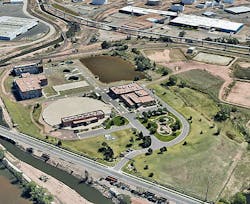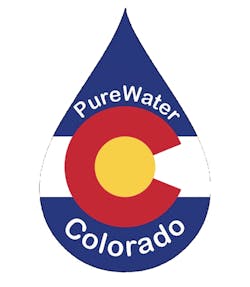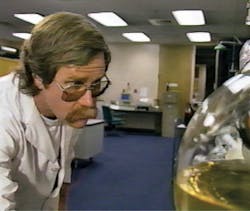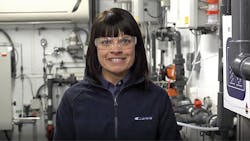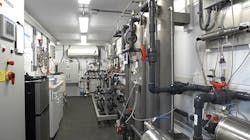Municipal water utilities are aiming to use existing water supplies more efficiently and to enhance the robustness and diversity of their water systems to protect against drought and other risks. To support this goal, many utilities are turning to direct potable reuse (DPR), in which purified reclaimed water is introduced directly into a potable water supply distribution system or into the raw water supply immediately upstream of a water treatment plant.
In the late 1980s and early 1990s, Denver Water pioneered DPR in the United States with a 1 million gallon per day (mgd) offline treatment facility. With this facility, they demonstrated treatment processes that could reliably clean secondary effluent from a water reclamation facility to potable water quality.
The DPR project of the 1980s achieved its water quality and public education goals. However, the need for implementing DPR in Denver Water’s system has not yet materialized, in part due to Denver Water’s aggressive water conservation efforts. Still, DPR remains an important option in Denver Water’s long-term water supply planning.
Nearly 30 years after Denver Water’s pioneer project, several Colorado water utilities are now considering DPR as part of their plans to take full advantage of reusable supplies. In 2018, a coalition of Colorado water providers and industry members conducted a DPR demonstration to advance regulatory development, public outreach, and engagement, and to show the viability of a treatment process that does not generate significant waste products.
Both pilots provided many lessons that utilities everywhere can use when considering and implementing DPR.
THE 1980S DEMONSTRATION
Thirty years ago, water supply drivers were foreseeable but not urgent, and public outreach efforts relied solely on work completed on-site — there were no operational full-scale potable reuse systems to reference in other states. Denver Water, however, anticipated a future need for such systems and implemented a 1-mgd demonstration facility that operated from 1985 to 1993, using secondary effluent from a regional water reclamation facility.
After years of preliminary study and research, Denver Water conducted the project with $7 million in funding from the Environmental Protection Agency (EPA). A project advisory committee, comprising various engineering companies, universities, health departments and EPA, guided the effort.
Advanced treatment options in the facility of the 1980s included a reverse osmosis (RO)/air stripping/ozonation train and an ultrafiltration/air stripping/ozonation train, providing diverse operational capabilities. Testing was conducted on microbiological and inorganic constituents as well as reproductive toxicity.
Finished water from the demonstration plant had no statistical differences compared to traditional potable water quality. Furthermore, water produced from the facility met and exceeded all federal and state of Colorado water quality standards. According to a rigorous toxicity and health effects study, the finished water showed no differences compared to Denver Water’s drinking water.
For the project, several outreach efforts were conducted, including tours, messaging, brochures, videos, and conferences, attracting international attention and visitors. Denver Water found that the public was generally open to potable reuse, although visitors from other countries were often more willing to sample the purified water.
PUREWATER COLORADO 2018
Since the 1980s, Colorado has seen strong population and economic growth, a trend that is expected to continue well into the future, with the state’s population predicted to nearly double by 2050. The 2015 Colorado Water Plan predicted a potential shortage in municipal and industrial (i.e., public water system) water supplies of as much as 560,000 acre-feet per year by 2050. The statewide water plan recognized the role that potable reuse can play in addressing these shortages, noting that “potable reuse will be an important facet of closing the gap.”
The demonstration project was operated from January through April 2018 as an extension of the WateReuse Colorado DPR project and would be known as PureWater Colorado.
The process train was notable in that it did not use RO to achieve its aggressive goals for pathogen and trace organic chemical reduction. As a result, it did not produce a concentrated brine waste that needed to be disposed of in a landlocked state.
PureWater Colorado used the following processes in series:
- Ozone
- Biofiltration
- Microfiltration
- Granular activated carbon
- Ultraviolet light (UV)/advanced oxidation
The process eliminated pathogens and had near-total removal of trace organic constituents.
The demonstration was made possible by a collaborative effort between Denver Water, Carollo Engineers, the Colorado Water Conservation Board, Xylem, Pall Corp., and Calgon Carbon. The project was conducted in conjunction with a broader DPR outreach program developed by WateReuse Colorado.
The 2018 PureWater Colorado demonstration revived outreach efforts for DPR as a water supply option for Colorado and western communities, building on the groundbreaking work from the 1980s and from recent efforts across the country to investigate and implement DPR safely. Diverse audiences were reached and nearly 200 tour attendees from utilities, agencies, legislators and academic institutions visited the demonstration facility and tasted the finished water over four weeks.
The project offered context for ongoing DPR dialog with key Colorado stakeholders, supporting Colorado’s efforts to develop DPR regulations and promote DPR outreach. Outreach materials included a YouTube virtual tour, printed and web-based materials, and beer and wine made from purified water through a partnership with local manufacturers. Proceeds from the beer sales were used to support student scholarships in water-related careers.
PureWater Colorado helps prepare Colorado for future DPR projects via a tangible, physical context for regulatory development and public outreach.
THE EVOLUTION OF POTABLE REUSE
The 2018 demonstration showed progress from the basic conception of potable reuse in the following key areas.
Technology: The treatment processes used in the 1980s demonstration, such as RO, are still common in pilot- and full-scale reuse facilities today. In the 1980s project, the RO system had limited use because it cost more than other processes, not unlike RO today. However, with ongoing technology development, the cost and footprint of the same technologies used in the 1980s has decreased. Real-time monitoring technology is continuing to advance for DPR treatment systems.
Drivers for potable reuse: Concerns over water supply continue to drive the consideration of using potable reuse and alternate supplies. As we face the effects of climate change on water supply reliability, more focus will be on drought-resistant supplies, such as water reuse, and on increasing the awareness of the value of a diversified supply portfolio.
Public engagement: While non-potable reuse is now commonplace—and even expected in many areas—potable reuse brings a new level of public scrutiny. Thus, public outreach and targeted education approaches are critical to the success of any potable reuse project. Today, we have tools and vehicles for outreach that we lacked 30 years ago. For example, we can use social media and websites for public engagement and acceptance. Now, communities have years of experience and data on potable reuse implementation, helping provide evidence to regulators and the public that potable water can be safely produced with DPR.
Regulatory development: Regulations for potable reuse vary from state to state, both in their development status and requirements. Currently, potable reuse has no federal-level regulatory program. However, unlike in the 1980s, several states have developed regulations for water supply augmentation via potable reuse, providing a baseline foundation for regulatory development in other states.
LOOKING FORWARD
In many areas of the country, potable reuse is in place to augment streams, reservoirs, and groundwater. DPR is not widespread, but its use can be expected to expand in the coming years with ongoing technology advancements, regulatory development, and increasing public awareness and acceptance. DPR demonstrations like the two in Denver—though nearly 30 years apart—will continue to be key for advancing the science and policy needed to support the expanded, safe implementation of DPR.
About the Author
Myron Nealey
Myron Nealey is a senior engineer at Denver Water. He worked at the Potable Reuse Demonstration Plant and now works in the planning, analysis and
design of Denver Water’s potable and recycled water distribution systems.
Austa Parker
Austa Parker is a lead planner at Denver Water in the Recycled Water and Efficiency group. She managed the 2018 PureWater Colorado DPR demonstration
facility with Carollo Engineers.
John Rehring
John Rehring is a vice president and senior project manager at Carollo Engineers in Broomfield, Colo. He has over 25 years of experience in water supply planning and implementation, including the PureWater Colorado direct potable reuse (DPR) demonstration and development of a Colorado DPR regulatory framework and outreach plan.

